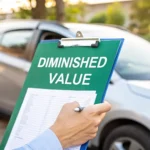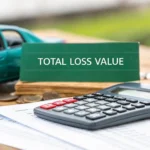Wondering how much an accident can devalue a car? Even after the dents are gone and the paint looks perfect, a collision leaves a lasting mark on your vehicle’s resale price. This hidden cost is called diminished value—the permanent loss in your car’s resale value simply because it now has an accident on its record. A car with a collision history is worth less than an identical one with a clean record, and you have the right to be compensated for that loss.
So, how much does an accident devalue a car? Even with top-notch repairs, a vehicle can lose anywhere from 10% to 30% of its pre-accident value.
Why Your Car Is Worth Less After an Accident
Imagine you’re buying a used car. You find two identical models with the same mileage and features. One has a clean vehicle history, but the other was in a collision last year. Which one would you choose?
Even if the repaired car looks and drives like new, the accident history is a permanent red flag on vehicle history reports like CarFax. A smart buyer will always offer less for the car with a crash in its past or simply walk away.
This immediate drop in resale value is what experts call inherent diminished value. It has nothing to do with the quality of the repairs; it’s all about the stigma of the accident itself. You have a legal right to be compensated for this loss, but don’t expect the at-fault driver’s insurance company to bring it up first.
Putting a Number on the Loss – How Much Value Does a Car Lose After an Accident?
This isn’t just a hypothetical problem—it’s a real, measurable financial loss. Studies and real-world market data consistently show that a vehicle’s value drops between 10% and 30% after an accident, even with flawless repairs. The market simply assumes a wrecked car, no matter how well it’s fixed, carries a higher risk of future problems or hidden damage.
If you want to get that money back, the burden is on you to prove exactly how much value your car has lost. This is where understanding the claims process is crucial. For a deeper dive, check out our guide on what a diminished value claim is.
Of course, if the damage is so severe that repairs don’t make financial sense, you might have atotal loss on your hands or need to explore options for getting cash for damaged cars. But for most people, the goal is to get their car fixed right and then recover the value it lost in the process.
Understanding the Three Types of Diminished Value
When you hear “diminished value,” it’s easy to think of it as a single loss. But the drop in your car’s worth after an accident actually breaks down into three distinct categories. Understanding these types is the first step to building a strong claim and getting fair compensation.
Inherent Diminished Value
This is the most common and unavoidable type of loss. Inherent Diminished Value is the automatic hit your car’s resale value takes just because it now has an accident on its record. Even with perfect repairs from the best shop in town, that history is now permanently attached to your vehicle’s CarFax report.
Think of it like this: a collector’s edition comic book gets a tear and is professionally restored. It might look fantastic, but to any serious buyer, it will never be worth the same as a pristine, undamaged copy. That’s exactly what happens to your car. The moment an accident appears on a vehicle history report, savvy buyers will expect a lower price.

This loss in fair market value is influenced by the severity of the accident, the age and desirability of your car, and other market factors.
Repair-Related and Immediate Diminished Value
Beyond the stigma of the accident itself, the actual repair work can also cause a loss in value.
- Repair-Related Diminished Value: This loss comes from repairs that are less than perfect. Maybe the paint doesn’t quite match, the body shop used cheaper aftermarket parts instead of factory originals (OEM), or there are new rattles that weren’t there before. These flaws give a potential buyer concrete reasons to demand a lower price.
- Immediate Diminished Value: This is a more technical term for the difference in the car’s value right after the crash but before any repairs. It’s essentially the resale price of the wrecked vehicle compared to its pre-accident value. While not typically part of a standard claim, it’s the foundational concept for calculating a total loss.
For most people filing a claim, the primary focus is on recovering inherent diminished value. It represents the most substantial and lasting financial damage you suffer as a vehicle owner.
Proving these losses takes more than just showing a CARFAX report. A certified appraisal from a service like SnapClaim provides proof and gives you the hard data and market analysis needed to back up your case. Our money-back guarantee means there’s no risk—if the insurance recovery from the claim is less than $1,000, the appraisal fee is fully refunded.
What Determines Your Car’s Devaluation Amount
Knowing your car has lost value is one thing; figuring out how much is another. That number isn’t just pulled from thin air. Insurance companies and appraisers look at several key factors to determine your vehicle’s exact diminished value.
Understanding these variables is the first step toward knowing what your claim is truly worth and preparing for negotiations. Remember, every car and every accident is different, which means the financial hit will be unique every time.

Key Factors in Diminished Value Calculation
- Pre-Accident Condition and Vehicle History: Everything starts with what your car was worth moments before the crash. An older car with high mileage will lose less in dollar terms than a new, low-mileage vehicle. Similarly, a car with a previous accident on its record won’t take as big of a hit as one with a perfectly clean history.
- Severity and Nature of the Damage: This is the biggest piece of the puzzle. A minor fender-bender won’t devalue a car nearly as much as a collision that results in structural or frame damage. Any mention of frame damage is a massive red flag for buyers, as it raises concerns about long-term safety and reliability. Accidents involving airbag deployment also signal a severe impact that will cause higher diminished value.
- Make, Model, and Market Desirability: The type of car you drive matters. High-end luxury cars, sports cars, and newer SUVs tend to lose a larger percentage of their value because buyers in that market expect perfection. An older, common economy car is less likely to see such a dramatic drop.
The global market highlights how much an accident history matters. In New Zealand, a car’s value can plummet by over 50% after just 56,000 kilometers. An accident record makes that depreciation curve even steeper. You can read more about global vehicle depreciation trends to see this in action.
Not sure where your vehicle falls? You can get a free diminished value estimate to get a clearer idea of what you might be owed.
How Insurance Companies Calculate Your car loss value after an accident
After you file a diminished value claim, you might expect the insurance company to conduct a detailed market analysis to determine your car’s loss. That’s rarely what happens.
Frankly, their goal is to pay out as little as possible. To do that, they often rely on internal, standardized formulas that are designed to produce the lowest possible number.
The Infamous “17c” Formula
The most common—and notorious—of these is the “17c” formula. The name might sound official, but it’s really just a simple, systematic way to minimize your claim amount. It starts with a base number and then applies a series of caps and modifiers that almost always lead to a lowball offer. You can read more about State Farm Mut. Auto. Ins. Co. v. Mabry.
Here’s a simple breakdown of how this flawed formula works:
- Cap the Loss: It starts by capping the maximum possible diminished value at just 10% of your car’s fair market value. This is a huge problem, as a vehicle with significant frame damage could easily lose 20% or more of its value.
- Apply a Damage Modifier: They then reduce that number based on the severity of the damage. While this seems logical, the modifier always lowers the payout.
- Apply a Mileage Modifier: Finally, they slash the number again based on your car’s mileage, penalizing vehicles that have been on the road longer.
The 17c formula is a tool built to serve the insurance company’s bottom line. It’s a calculation designed for their savings, not for making you financially whole again after an accident.
This is why their initial offer should always be seen as a starting point for negotiations, not a final assessment of your loss. To get a more realistic figure, use an independent tool like SnapClaim’s diminished value claim calculator, which isn’t designed to protect an insurer’s profits.
Countering Their Lowball Offer
Knowing how their formula works is the first step to fighting back. The only way to effectively challenge a low offer is to come prepared with independent, verifiable proof of your car’s true loss in value.
This is where a certified appraisal report is non-negotiable. It replaces their self-serving formula with what actually matters: real-world market data, sales comparisons of similar vehicles, and an expert analysis of your specific car and accident. A certified report helps strengthen your claim and supports negotiations with the insurer.
How a Certified Appraisal Strengthens Your Claim
When negotiating with an insurance company, your opinion alone won’t get you far. You need to counter their lowball offer with concrete proof, and that’s exactly what a professional, independent appraisal provides. Think of it as the single most powerful tool you have to close the gap between their offer and what you’re actually owed.
A certified appraisal provides the proof needed to negotiate fair compensation.
From Your Word to Hard Evidence
A thorough report from a certified appraiser isn’t just a number; it’s a methodical, unbiased valuation of your vehicle’s true diminished value, grounded in real-world market data. This document turns your request for payment into a serious, evidence-based demand. An appraisal is a cornerstone of a successful claim strategy, as we break down in our guide on getting a car appraisal after an accident.
What’s Inside a Professional Report
A high-quality appraisal report tells the complete story of your financial loss by documenting every factor that impacts your car’s value. Here’s what it typically includes:
- Pre-Accident Fair Market Value: Establishes a clear baseline of what your car was worth right before the collision.
- Detailed Repair Scrutiny: An expert examines the repair work for inconsistencies, shoddy workmanship, or the use of non-OEM parts that can hurt its value.
- Market Sales Data: This is the core of the proof—it shows real-world sales data for cars just like yours, comparing ones with clean histories to those with an accident record.
- Expert Conclusion: The certified appraiser provides their final, professional opinion on the exact dollar amount of your diminished value.
An appraisal report speaks the language insurance companies understand: data, market analysis, and professional certification. It shows you’ve done your homework and are serious about recovering the full amount you’re owed.
This data-driven approach is critical. A major international study found that the average car depreciation in OECD countries is around 31% over a set period, and an accident history only accelerates that loss. You can learn more about these global depreciation findings to see just how much an accident record matters worldwide.
At SnapClaim, we stand by our reports with a money-back guarantee. If the insurance recovery from the claim is less than $1,000, your appraisal fee is fully refunded. This makes it a risk-free decision to arm yourself with the proof you need.
Take Control and Reclaim Your Car’s Lost Value
Knowing what diminished value is and how an accident devalues your car is the first step. Actually getting paid for it is the next. You can’t just accept the financial hit from an accident that wasn’t your fault, but the insurance company isn’t going to hand over the money without a fight. The responsibility to prove your loss falls squarely on you.
Think of the insurance company’s first offer as an opening bid. Your goal is to counter their lowball number with undeniable proof of your car’s actual loss in fair market value. A certified appraisal report from SnapClaim provides the proof to strengthen your claim and support your negotiations.
While a professional detail can make your car look great (and you might wonder, Is a Full Car Detail Worth It), that’s about cosmetic appeal. A diminished value claim is about recovering the deep, structural loss to your car’s resale price.
For a complete walkthrough of the process, be sure to read our guide on how to file a diminished value claim.
An independent appraisal is your greatest advantage. It forces the conversation away from the insurer’s self-serving formulas and grounds it in objective, real-world market data.
Ready to see what you’re owed? When you’re ready to move forward, arm yourself with a SnapClaim certified report. It’s backed by our money-back guarantee—if you don’t recover at least $1,000, we’ll refund your fee completely.
FAQ: Your Diminished Value Questions Answered
Dealing with the aftermath of a car accident can be confusing. Here are answers to a few common questions about how much an accident can devalue a car and what you can do about it.

Can I file a diminished value claim if I caused the accident?
In almost all cases, the answer is no. Diminished value is considered a third-party claim, meaning you file it against the at-fault driver’s insurance policy. The logic is that their client’s negligence caused your property (your car) to lose value, so their policy should cover that loss. Your own insurance policy is for first-party claims and is designed to cover repairs to your vehicle, not its drop in resale value.
What is the time limit for filing a diminished value claim?
Every state has a legal deadline for filing property damage claims called the statute of limitations. This is typically two or three years from the date of the accident, but it varies by state. You can find specifics for your area on your local Department of Motor Vehicles (DMV) website. However, it is always best to act quickly. The sooner you file, the stronger your case will be and the easier it is to connect the loss in value directly to the accident.
Is it worth paying for a certified appraisal?
Yes, absolutely. An appraisal is a small investment that can significantly strengthen your claim. The insurance adjuster’s initial offer is often based on a formula like 17c, which is designed to minimize their payout. An independent appraisal report provides objective proof of your car’s lost value, giving you the leverage needed to negotiate a fair settlement. Plus, SnapClaim’s money-back guarantee makes it a risk-free choice. If your insurance recovery is less than $1,000, you get a full refund on the appraisal fee.
About SnapClaim
SnapClaim is a premier provider of expert diminished value and total loss appraisals. Our mission is to equip vehicle owners with clear, data-driven evidence to recover the full financial loss after an accident. Using advanced market analysis and industry expertise, we deliver accurate, defensible reports that help you negotiate confidently with insurance companies.
With a strong commitment to transparency and customer success, SnapClaim streamlines the claim process so you receive the compensation you rightfully deserve. Thousands of reports have been delivered to vehicle owners and law firms nationwide, with an average of $6,000+ in additional recovery per claim.
Why Trust This Guide
This article was reviewed by SnapClaim’s team of certified auto appraisers and claim specialists with years of experience preparing court-ready reports for attorneys and accident victims. Our content is regularly updated to reflect the latest industry practices and insurer guidelines.
Get Started Today
Ready to prove your claim? Generate a free diminished value estimate in minutes and see how much you may be owed.
Get your free estimate today





